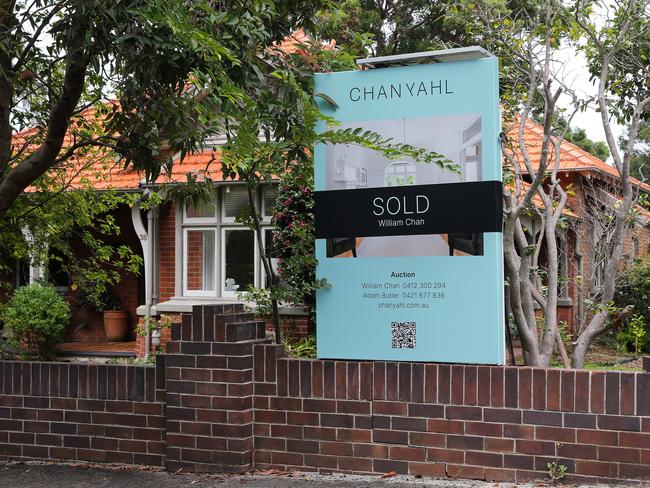Aussie real estate boom is over
Australia’s runaway real estate prices are expected to hit the brakes over the next 18 months, with rent costs also tipped to cool.
Property
Don't miss out on the headlines from Property. Followed categories will be added to My News.
Australia’s runaway real estate prices are expected to hit the brakes over the next 18 months, with rent costs also tipped to cool.
According to a new report from KPMG Australia, house price growth is expected to dip significantly over the next 18 months.
Per KPMG’s Residential Property Market Outlook June 2024, house prices will rise across the country by 5.3 per cent over the next six months through to the end of 2024. They are then expected to rise by 5.6 per cent across the capital cities in 2025.
This is down from the supercharged 7.7 per cent national rise in house prices over the 12 months through March 2024 – the latest figures released.
According to PropTrack, home price growth for all dwellings rose 7.22 per cent across the capital cities through to the end of May.

Dr Brendan Rynne, KPMG Chief Economist, said: “In a year of high interest rates and inflation and subdued consumer sentiment the housing market has withstood all those factors and still provided strong price growth, due to demand outstripping supply.
“Even the much-anticipated ‘fixed-rate cliff’ – the transition of mortgage holders off lower fixed rates to higher variable rates – has only had a mild impact and households have so far coped well with the rate rises, due to a robust labour market and Australia’s historic low unemployment rate.”
The news will come as welcome relief to homeseekers, with better news on the horizon also for renters, with the growth in rent prices expected to almost halve over the next two years.
KPMG expects rents to rise by 4-5 per cent over the next two years, well down on the 7.8 per cent increase of the past year – the largest since the GFC in 2008/9.
“Supply has remained insufficient, and while we do forecast a slight rise in housing approvals, this will take time to translate into actual housing completions, due to the time lag inherent in the process,” Dr Brendan Rynne said.
“Although material costs and financing costs have started to stabilise after sustained increases, labour costs continue to increase in response to high demand for qualified tradespeople.
“Many barriers remain to developers building new homes, while continuing high rental costs are pushing renters to look to buy instead, which is pushing up demand.
“After the exceptional house price increases we have seen in several capital cities over the past 12 months, we do forecast a slowdown in the rate of growth, given the drop in migration, the delayed impact of high interest rates and a predicted increase in unemployment over the rest of this year.
“Foreign investment activity has also yet to regain its levels of two years ago. But overall we will still see solid price gains over the next 18 months, especially in 2025, as the RBA starts to introduce interest rate cuts, as we anticipate”.
The country-leading home price growth in Perth is expected to hit the brakes, alongside the other capitals, KPMG estimates.
“For the next six months, there will be considerable national variation with Perth house prices rising by over 10 per cent while Darwin and Hobart only experiencing 1.4 per cent growth,” the report says.
“For units, the predicted increases range from Perth’s 8.6 per cent to Canberra’s 1.3 per cent.
However in 2025, far greater house price growth consistency is expected across the country. Melbourne houses will rise the most by 6.5 per cent followed by Canberra at 6.0 per cent. Brisbane will still rise by 5.1 per cent.
By contrast, units will still have considerable regional variation next year, ranging from Perth’s 8.0 per cent growth to Brisbane’s more modest 2.5 per cent increase.
The previous 12 months, to March 2024, saw a 7.7 per cent national rise in house prices – with Perth, Adelaide and Brisbane the standout performers – and 6.1 per cent in apartments.
The slower growth over the next six months is attributed to a slower rate of migration, and the cooling impact of high interest rates. Prices will then start rising slightly faster during 2025 as rate cuts start to be introduced by the RBA, as KPMG anticipates.
After house price growth far outpaces unit price growth during Covid and beyond, unit price growth is now very much in the ascendancy.
“Apartment prices across the country will see an average rise of 4.5 per cent by December and then match houses by growing by 5.6 per cent in the following 12 months,” the KPMG report says.
In Sydney, house prices are expected to grow 4.9 per cent until the end of 2025 then by 5.3 per cent through to the end of 2025.
This is down on Sydney’s annual house price growth of 7 per cent over the past 10 years, according to SQM research.
Melbourne has experience 5.8 per cent growth per annum over the past 10 year, s Brisbane 7.3 per cent, Adelaide 6.6 per cent and Perth 2.8 per cent.
Originally published as Aussie real estate boom is over





